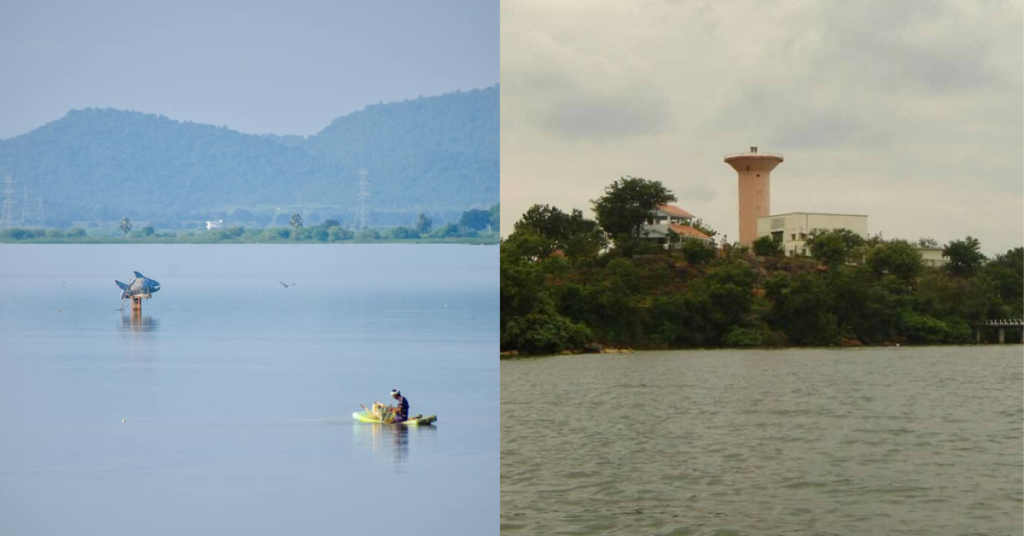Introduction:
The Wyra Reservoir, a critical water body nestled near Wyra village in Andhra Pradesh, stands as a testament to both historical engineering and modern significance. Established in 1930 and inaugurated by Dr. Sarvepalli Radhakrishnan, this reservoir is integral to the region’s water management, serving as a crucial source for irrigation and supporting local industries. With its expansive capacity of 3 TMCs, it not only sustains approximately 17,391 acres of agricultural land but also enriches the local ecosystem, offering habitat for diverse wildlife. As a hub of economic and ecological importance, the Wyra Reservoir exemplifies the harmony between human ingenuity and natural preservation.
Origins and Formation of Wyra River
The Wyra River, a vital tributary of the Munneru River and, in turn, a significant contributor to the Krishna River, begins its journey at the Wyra Reservoir. Located near Wyra village, the river’s origins are directly tied to this reservoir, which was established in 1930 by the Irrigation Department of Andhra Pradesh. The reservoir was inaugurated by Dr. Sarvepalli Radhakrishnan, the former President of India. Positioned at an elevation of 27 meters, the reservoir has a length of 1,768.3 meters and a height of 26 meters at its foundation. It features five spillway gates designed to manage water flow and maintain its structural integrity.
Hydrological Details
Wyra Reservoir’s primary function is to serve as a reliable source of water for irrigation and other needs. The reservoir has a capacity of 3 TMCs (Thousand Million Cubic Feet), which facilitates the irrigation of approximately 17,391 acres of agricultural land. The river originating from this reservoir flows through Madhira and eventually merges with the Munneru River after traveling 65 kilometers. This journey highlights the reservoir’s role in supporting the regional water cycle and agricultural activities.
Also read: Kinnerasani Dam: An Exclusive Information of Ecological Treasure
Economic and Ecological Significance
Beyond its role in agriculture, Wyra Reservoir plays a crucial role in the local economy. It provides water for various industrial activities and supports local fishing enterprises, which are integral to the livelihoods of many in the region. The reservoir also serves as a popular site for sightseeing, attracting visitors who enjoy its scenic beauty and recreational opportunities.
Ecologically, Wyra Reservoir is a vital habitat for a diverse range of aquatic and terrestrial species. The surrounding areas support various forms of wildlife, contributing to the region’s biodiversity. The reservoir’s consistent water supply fosters a stable environment for these species, making it a critical component of the local ecosystem.
Challenges and Conservation Efforts
Despite its importance, Wyra Reservoir faces several challenges threatening its long-term sustainability. Siltation is a significant issue, as sediment accumulation can reduce the reservoir’s storage capacity and impact water quality. Pollution from agricultural runoff and industrial activities further exacerbates these problems; moreover, it affects the reservoir’s ecosystem and utility for irrigation and other purposes. Equally important, in addition to these impacts, are the challenges posed to water quality.
Overexploitation of water resources also poses a threat, as increased demand can strain the reservoir’s capacity and disrupt its natural balance. To address these challenges, sustainable management practices are essential. Implementing measures to control pollution, manage siltation, and regulate water usage can help preserve the reservoir’s ecological health and ensure its continued benefits to the community.
Efforts to protect and restore the Wyra Reservoir are vital for maintaining its role as a lifeline for the region. By addressing these challenges through comprehensive conservation strategies, stakeholders can safeguard this valuable water resource for future generations.

Future Prospects of Wyra Reservoir
The Wyra Reservoir holds potential for further development and enhancement of its functions. Investments in modern technology and infrastructure improvements can enhance its efficiency and sustainability. Additionally, community involvement and awareness programs can play a crucial role in fostering a sense of stewardship and encouraging responsible use of the reservoir’s resources.
In conclusion, Wyra Reservoir is much more than a water body; it is a cornerstone of the local economy, ecology, and cultural landscape. Furthermore, it plays a crucial role in sustaining agriculture and industry. What’s more, it supports biodiversity and community life. In addition, its historical significance enriches the region’s heritage. By understanding its significance and addressing the challenges it faces, we can ensure that this vital resource continues to thrive and support the region for years to come.
conclusion:
Wyra Reservoir stands as a pivotal asset for the region, intertwining ecological, economic, and cultural significance. Its role as a primary water source for agriculture, industry, and recreation underscores its importance in sustaining local livelihoods and biodiversity. Despite facing challenges such as siltation, pollution, and overexploitation, the reservoir’s continued vitality depends on proactive conservation and sustainable management. Furthermore, it is equally important to address these issues through effective strategies. In addition, proactive measures and community involvement can further ensure its sustainability. Lastly, what’s more, consistent efforts will safeguard this vital resource for future generations. By embracing innovative solutions and fostering community stewardship, we can safeguard the reservoir’s future, ensuring that it remains a cherished and indispensable resource for generations to come.
“We’d love to hear from you! Whether you have a question, feedback, or a travel story to share, feel free to get in touch with us. Here’s how you can contact us:”
Frequently Asked Questions(FAQs)
Answer: The primary purpose of the Wyra Reservoir is to provide a reliable water source for irrigation, supporting approximately 17,391 acres of agricultural land.
Answer: The Wyra Reservoir was established in 1930 by the Irrigation Department of Andhra Pradesh and inaugurated by Dr. Sarvepalli Radhakrishnan.
Answer: The Wyra Reservoir faces challenges such as siltation, pollution from agricultural runoff and industrial activities, and overexploitation of water resources.
Answer: The reservoir provides a stable environment for a diverse range of aquatic and terrestrial species, contributing significantly to the region’s biodiversity.
Answer: Conservation efforts include managing pollution, controlling siltation, regulating water usage, and promoting community involvement to ensure the reservoir’s long-term sustainability.











